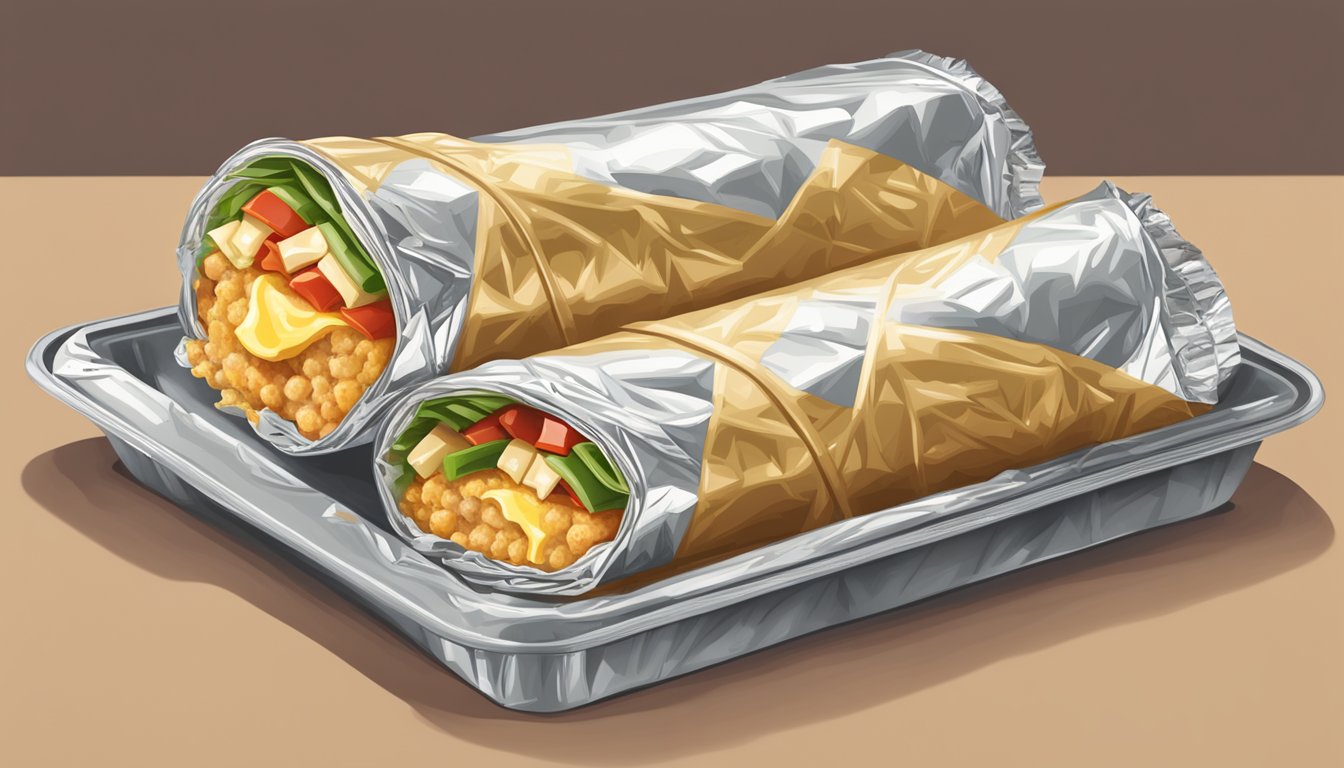Breakfast burritos offer a convenient and delicious way to start the day. For those seeking quick and easy breakfasts, these handheld meals can be prepared in advance and stored for later enjoyment. Breakfast burritos can indeed be frozen, allowing for meal prep and long-term storage.
Freezing breakfast burritos provides flexibility for busy mornings. By preparing a batch ahead of time, individuals can have a hearty breakfast ready in minutes. These frozen burritos typically stay fresh for up to 3 months when properly stored, making them an excellent option for those who value convenience and variety in their morning routine.
To ensure the best quality when freezing breakfast burritos, it’s important to let the ingredients cool before assembly and wrapping. This helps prevent soggy tortillas and maintains the texture of the fillings. Wrapping each burrito individually in foil and storing them in a freezer-safe bag further protects against freezer burn and preserves flavor.
Essentials of Freezing Breakfast Burritos
Freezing breakfast burritos is a convenient way to prepare meals in advance. Proper ingredients, preparation, and wrapping techniques are key to maintaining quality.
Choosing the Right Ingredients
Select ingredients that freeze well for the best results. Scrambled eggs, cooked meats like bacon or sausage, and shredded cheese are excellent choices. Avoid watery vegetables like lettuce or tomatoes, as they can make the tortilla soggy.
Opt for sturdy tortillas that won’t tear easily. Flour tortillas work better than corn for freezing. Choose larger sizes to accommodate ample fillings.
Consider using refried beans or potatoes as they freeze nicely and add substance. Pre-cook all ingredients and let them cool completely before assembly.
Preparation Before Freezing
Assemble burritos on a clean, dry surface. Place cooled ingredients in the center of each tortilla, leaving space at the edges for folding.
Don’t overstuff the burritos. Too much filling can lead to bursting during reheating. Aim for a balance of ingredients that allows for easy folding and sealing.
Fold the sides of the tortilla over the filling, then roll tightly from the bottom up. Ensure the burrito is sealed well to prevent freezer burn.
Let assembled burritos cool completely if any ingredients are still warm. This prevents condensation inside the wrapping, which can lead to ice crystals.
Wrapping Techniques for Freezing
Wrap each burrito individually for easy retrieval and reheating. Start with a layer of plastic wrap, covering the burrito tightly to eliminate air pockets.
Follow with a layer of aluminum foil for extra protection against freezer burn. Press the foil firmly around the burrito to create a tight seal.
Label each wrapped burrito with the date and contents using a permanent marker. This helps with organization and ensures timely consumption.
For added convenience, place wrapped burritos in a large freezer bag. Remove excess air from the bag before sealing to further prevent freezer burn.
Freeze burritos in a single layer initially. Once frozen solid, they can be stacked to save space.
Creating the Perfect Breakfast Burrito
The key to a delicious breakfast burrito lies in choosing quality ingredients and mastering the assembly process. A well-crafted burrito balances proteins, vegetables, and cheeses for optimal flavor and texture.
Selecting Your Proteins
Eggs form the foundation of most breakfast burritos. Scramble them until just set for a soft, creamy texture. Bacon adds a smoky crunch – cook it until crisp, then crumble. Breakfast sausage provides rich, savory flavor. Brown and crumble the sausage, draining excess grease. For a leaner option, try turkey bacon or sausage.
Combine multiple proteins for variety. A popular mix is scrambled eggs with crumbled bacon and sausage. Adjust ratios based on preference. Two to three eggs and 2-3 ounces of meat per burrito works well for most.
Adding Vegetables and Beans
Vegetables add nutrition, flavor, and texture. Bell peppers bring sweetness and crunch. Dice them small and sauté briefly. Onions provide savory depth – cook until softened. Potatoes bulk up burritos nicely. Use hash browns or tater tots for convenience.
Black beans offer protein and fiber. Rinse canned beans well before adding. For extra flavor, simmer beans with spices like cumin and chili powder.
Aim for about 1/2 cup total vegetables and beans per burrito. This provides ample filling without overpowering other ingredients.
Choosing the Best Cheeses
Cheese binds ingredients and adds creamy richness. Cheddar is a classic choice, melting smoothly and providing sharp flavor. Monterey Jack offers milder taste and excellent meltability. Pepper Jack adds a spicy kick.
Shred cheese finely for even distribution. Use about 1/4 cup per burrito. For extra indulgence, mix cheeses – try cheddar with Jack for a balance of flavor and melt.
Wrapping Your Burrito
Large flour tortillas (10-12 inch) work best for breakfast burritos. Warm them slightly for easier folding. Place fillings in the center, leaving a border around edges.
To wrap:
- Fold bottom edge up over filling
- Fold sides in towards center
- Roll tightly from bottom up
Tuck sides as you roll to secure the filling. For neater burritos, fold sides in before rolling. A tight wrap prevents filling from falling out during eating or freezing.
Freezing and Storing Techniques
Proper freezing and storage techniques ensure breakfast burritos maintain quality and taste for extended periods. Careful wrapping, quick freezing, and appropriate thawing methods are key to preserving these convenient meals.
Best Practices for Freezing
Wrap each burrito individually in aluminum foil to prevent freezer burn. Remove as much air as possible when sealing. For extra protection, place foil-wrapped burritos in a freezer-safe plastic bag. Freeze burritos in a single layer on a baking sheet before transferring to long-term storage containers. This quick-freezing method helps maintain texture.
Label each burrito with contents and date for easy identification. Avoid overstuffing burritos to prevent ingredients from spilling during the freezing process. Let ingredients cool completely before assembly to prevent excess moisture.
Thawing and Reheating Instructions
Thaw frozen burritos in the refrigerator overnight for best results. For quicker thawing, use the defrost setting on a microwave. Remove foil before microwaving to prevent sparking.
To reheat, remove foil and wrap burrito in a damp paper towel. Microwave on high for 1-2 minutes, turning halfway through. For a crispy exterior, reheat in a preheated 375°F oven for 15-20 minutes.
Avoid reheating multiple times to maintain food safety and quality.
Long-Term Storage Tips
Store frozen breakfast burritos for up to 3 months in a freezer set at 0°F (-18°C) or below. Use airtight containers or heavy-duty freezer bags to prevent freezer burn and maintain freshness.
Organize burritos in the freezer for easy access. Consider using a labeling system to track storage dates. Rotate stock, using older burritos first.
For freezer-friendly breakfast burritos with eggs, cook eggs slightly less than usual to prevent overcooking when reheating. Avoid high-moisture ingredients like fresh tomatoes or lettuce, which can become soggy when frozen.
Flavorful Additions and Variations

Enhancing frozen breakfast burritos with creative ingredients and bold flavors can elevate them from basic to gourmet. Experiment with herbs, spices, sauces, and unique fillings to customize your burritos.
Incorporating Fresh Herbs and Spices
Fresh herbs add bright flavors and aromas to breakfast burritos. Chop cilantro and sprinkle it over scrambled eggs for a Mexican-inspired taste. Basil pairs well with Italian-style fillings, while chives complement cheese and potato combinations.
For a spicy kick, add diced jalapeños or a dash of cayenne pepper. Cumin and smoked paprika bring warmth and depth to the flavor profile. A pinch of garlic powder enhances savory fillings without overpowering other ingredients.
Experiment with spice blends like taco seasoning or za’atar for unique flavor profiles. These can be mixed into eggs or sprinkled over fillings before rolling the burritos.
Using Salsas and Sauces
Salsas and sauces add moisture and zest to frozen breakfast burritos. Spread a thin layer of salsa verde or pico de gallo inside the tortilla before adding other fillings. This prevents sogginess and infuses flavor throughout the burrito.
Hot sauce enthusiasts can drizzle their favorite variety over scrambled eggs or meat fillings. For a creamy option, mix sour cream with chipotle peppers in adobo sauce. This adds smoky heat and richness to the burrito.
Consider unconventional sauces like hollandaise or chimichurri for gourmet variations. These can be frozen separately and added after reheating the burrito for maximum flavor impact.
Creative Filling Ideas
Beyond traditional ingredients, breakfast burritos can accommodate a wide range of creative fillings. Swap regular potatoes for sweet potatoes or butternut squash for a nutritious twist. Add black beans or refried beans for extra protein and fiber.
Experiment with different cheeses. Crumbled queso fresco adds authentic Mexican flavor, while melted Monterey Jack cheese provides a creamy texture. For a bold taste, try pepper jack or smoked gouda.
Incorporate unexpected ingredients like corn kernels, diced bell peppers, or sautéed mushrooms for added texture and nutrients. Vegetarians can use plant-based sausage or tofu scramble as meat alternatives.
For a breakfast-meets-lunch option, add sliced avocado or guacamole. These can be frozen separately and added after reheating to maintain freshness and prevent discoloration.
Nutrition and Dietary Considerations

Breakfast burritos offer a mix of nutrients and can be adapted to various dietary needs. Their nutritional profile depends on ingredients and preparation methods.
Calorie and Macronutrient Breakdown
Frozen breakfast burritos typically contain 250-400 calories each. The macronutrient balance varies, but often includes:
- Protein: 10-20g
- Carbohydrates: 25-40g
- Fat: 10-20g
Protein sources may include large eggs, cheese, or meat alternatives. Carbs come from tortillas and fillings like potatoes or beans. Fats are present in cheese, meats, and cooking oils.
Some brands offer high-protein options with up to 20g per serving. Others focus on lower-calorie versions around 250 calories each.
Gluten-Free and Vegetarian Options
Many brands now cater to specific dietary requirements. Gluten-free burritos use corn or alternative grain tortillas. These options are suitable for those with celiac disease or gluten sensitivity.
Vegetarian burritos replace meat with plant-based proteins like:
- Tofu scramble
- Black beans
- Soy-based meat alternatives
These options often have similar protein content to meat-based versions. They may provide additional fiber from legumes and vegetables.
Some vegetarian burritos use large eggs as a protein source. Others are fully vegan, using only plant-based ingredients.
Balancing Macros for a Hearty Breakfast
A balanced breakfast burrito should provide a mix of macronutrients. Aim for:
- 15-20g of protein
- 30-40g of complex carbohydrates
- 10-15g of healthy fats
This combination helps maintain steady blood sugar levels and provides lasting energy. Adding vegetables increases fiber and micronutrient content.
To boost nutritional value, pair a frozen burrito with fresh fruit or a side salad. This adds vitamins, minerals, and fiber to the meal.
Consider sodium content when choosing frozen burritos. Many contain 400-600mg per serving. Opt for lower-sodium options when possible.
Serving and Presentation
Frozen breakfast burritos offer convenience without sacrificing flavor. Proper serving techniques and thoughtful presentation can elevate these handheld meals into satisfying culinary experiences.
How to Serve Frozen Breakfast Burritos
Thaw frozen burritos in the refrigerator overnight for best results. For quick reheating, use a microwave or oven. Microwave on high for 1-2 minutes, rotating halfway through.
In an oven, wrap burritos in foil and bake at 350°F (175°C) for 15-20 minutes. For a crispy exterior, unwrap and broil for 1-2 minutes after baking.
Let burritos rest for 1-2 minutes before serving to allow heat to distribute evenly. Cut in half diagonally for easier handling and a more appealing presentation.
Accompaniments and Side Dishes
Enhance frozen breakfast burritos with flavorful accompaniments. Serve with a side of fresh guacamole or sliced avocado for creamy texture. Add a dollop of sour cream for tangy richness.
Pico de gallo provides a fresh, zesty contrast to the warm burrito. For added crunch and flavor, sprinkle chopped green onions on top.
Consider serving burritos with a simple side salad or fresh fruit for a balanced meal. A small portion of crispy hash browns or roasted potatoes can complement the burrito nicely.
Plating and Garnishing Tips
Present burritos on colorful plates to create visual appeal. Arrange halves slightly overlapping for an attractive display. Garnish with a sprinkle of shredded cheddar cheese for added flavor and color.
Create a small bed of shredded lettuce as a base for the burrito. This adds freshness and prevents the burrito from sliding on the plate.
For a professional touch, drizzle a zigzag of hot sauce or cilantro-lime crema across the burrito. Add a small ramekin of salsa or additional toppings on the side for customization.
Use fresh herb sprigs, such as cilantro or parsley, as a final garnish to add a pop of color and freshness to the plate.
Advanced Meal Prep Strategies
Efficient meal prep techniques can save time and streamline the process of making freezer-friendly breakfast burritos. These strategies focus on maximizing productivity and ensuring consistent quality across batches.
Cooking in Batches
Preparing ingredients in large quantities is key to efficient meal prep. Cook scrambled eggs in a large skillet or on a griddle to make multiple servings at once. Brown sausage or bacon in bulk, then drain and cool before assembling burritos.
Use a rice cooker to prepare a large batch of rice or potatoes. Chop vegetables like bell peppers and onions in advance, then sauté them all together.
Consider making 20-30 burritos at a time for optimal efficiency. This quantity typically provides enough for 2-3 weeks of quick breakfasts for an individual or a week’s worth for a family.
Organizing a Meal Prep Day
Dedicate a specific day for meal prepping breakfast burritos. Start by gathering all ingredients and equipment needed. Set up assembly stations on the counter for efficient workflow.
Cook proteins and grains first, as they take the longest. While those cook, chop vegetables and grate cheese. Once all components are ready, begin the assembly process.
Lay out tortillas on a clean surface. Add fillings in the center of each tortilla, being careful not to overfill. Roll burritos tightly, tucking in the sides as you go.
Effective Use of Kitchen Appliances
Utilize kitchen appliances to speed up the cooking process. A food processor can quickly chop vegetables or grate cheese. An electric griddle allows for cooking multiple servings of eggs or hash browns simultaneously.
For homemade breakfast burritos, a slow cooker can be used to prepare shredded chicken or pork overnight. This ensures tender, flavorful meat ready for assembly in the morning.
A vacuum sealer is excellent for packaging frozen burritos. It removes air, preventing freezer burn and extending shelf life. If a vacuum sealer isn’t available, wrap burritos tightly in parchment paper before placing them in freezer bags.
Common Mistakes to Avoid
Proper preparation and storage are crucial for maintaining the quality of frozen breakfast burritos. Avoiding common pitfalls ensures your burritos remain delicious and safe to eat.
Avoiding Soggy Burritos
Excess moisture is the enemy of frozen burritos. Allow ingredients to cool completely before assembly. Drain wet ingredients like salsa or beans thoroughly. Use minimal sauces and condiments to prevent sogginess. Wrap burritos tightly in plastic wrap or aluminum foil to create a moisture barrier.
Consider placing a paper towel inside the burrito to absorb excess moisture. This can be removed before reheating. Slightly undercook eggs and vegetables to prevent them from becoming mushy when reheated.
Preventing Freezer Burn
Proper packaging is key to preventing freezer burn. Wrap each burrito individually in plastic wrap or aluminum foil. Remove as much air as possible to create an airtight seal. Place wrapped burritos in a freezer-safe container or heavy-duty freezer bag for added protection.
Consider using a vacuum sealer for maximum freshness. Store burritos in the back of the freezer where temperatures are most consistent. Avoid opening the freezer door frequently to maintain a stable temperature.
Properly Labeling for Freshness
Clear labeling is essential for tracking freshness and identifying contents. Use a permanent marker to write the date of preparation and contents on each wrapped burrito. Include any special ingredients or dietary information.
Create a simple labeling system:
- Date prepared
- Main ingredients (e.g. “Egg, Bacon, Cheese”)
- Any allergens
Consider using color-coded labels for different varieties. Store burritos in the freezer for no more than 2-3 months for best quality. Rotate stock, using older burritos first to maintain freshness.
Additional Tips and Tricks
Wrap burritos tightly in aluminum foil before freezing to prevent freezer burn. This also makes reheating easier.
Label each burrito with contents and date to keep track of freshness. Most frozen breakfast burritos stay good for up to 3 months.
Consider adding refried beans to your burritos. They freeze well and add protein and fiber.
Pre-cook and crumble ground beef or bacon before assembling burritos. This ensures even distribution and proper cooking.
Avoid overstuffing burritos to prevent ingredients from spilling out during reheating.
For quick meals, thaw burritos in the refrigerator overnight. This reduces microwave time and ensures even heating.
Meal planning tip: Make a large batch of burritos on weekends for grab-and-go breakfasts all week.
To prevent sogginess, let fillings cool completely before assembling burritos.
Try wrapping burritos in parchment paper before foil for an extra layer of protection against moisture.
For best texture, reheat frozen burritos in the oven or toaster oven instead of the microwave when time allows.




